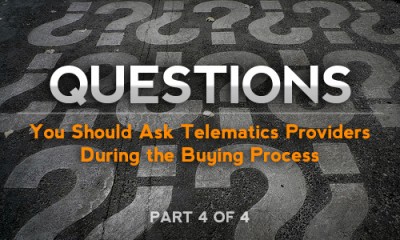This is the final blog post in a series of 4 from the Automotive Fleet Magazine 2013 Fleet Guide, “Questions You Should Ask Telematics Providers During the Buying Process.”
What is your process for deploying a solution smoothly and successfully?
Find out what each provider’s process is and figure out which will work best for you. A red flag should wave if the provider says, “all you need to do is install the devices and start tracking.” There is always a process to ensure a successful rollout. The best process would be:
1) Establish key metrics for improvement
2) Get executive buy-in
3) Do a proof of concept/pilot
4) Conduct regular reviews throughout the pilot
5) Produce a finished business case
6) Establish a roll out strategy and install schedule
7) Schedule training based on roles and use cases for the system
What are your purchasing options and terms?
Usually, you will have a purchase option which will involve paying for the devices upfront and then paying a monthly service fee. Most telematics companies require a contract of 3-5 years, but be aware that some companies do not require a contract at all. Keep this in mind, because what if you don’t like the software purchased, but you are locked into a multi-year commitment? For some companies, having no contract is a much better option.
If you choose the rental/subscription model, the upfront cost is eliminated. You pay for the hardware and software as a monthly bundle of just a few dollars more than the normal monthly fee would be if you purchased the devices. Contracts for rental/subscriptions are typically 1 year. For rentals, providers are fronting the cost of the hardware, so there will almost always be a contract.
How often is your telematics solution updated and is there a cost associated with this?
The Telematics space is constantly evolving, so GPS tracking companies need to always be updating and evolving their offerings. Most GPS tracking companies will update features in their product quarterly or annually with an official release of a new version. Some companies update more frequently to stay ahead of the curve, providing cutting-edge features and technology as it becomes available. This way there is no waiting period for requested features or new technologies. Make sure the GPS tracking company you choose is a leader in innovation. This will only benefit your company.
Most of the time, these upgrades and new versions come at no cost to the customer.
Can your telematics solution be utilized by any number of users with different user permissions?
With every company, there is a hierarchy, and not everyone has access to the same level of intel as others. You could have city managers, state-wide managers, regional managers, etc. All in charge of different groups, in need of different permissions.
Make sure that your GPS tracking software does not have licenses; you wouldn’t want to be restricted to how many users you could have. Also make sure that you can control the level of permissions for each user.
What makes your solution and approach unique?
Find out what separates one telematics company from the next. Investigate their sales approach, the look and feel of the software, the ROI they can provide, and the quality of their customer service.






